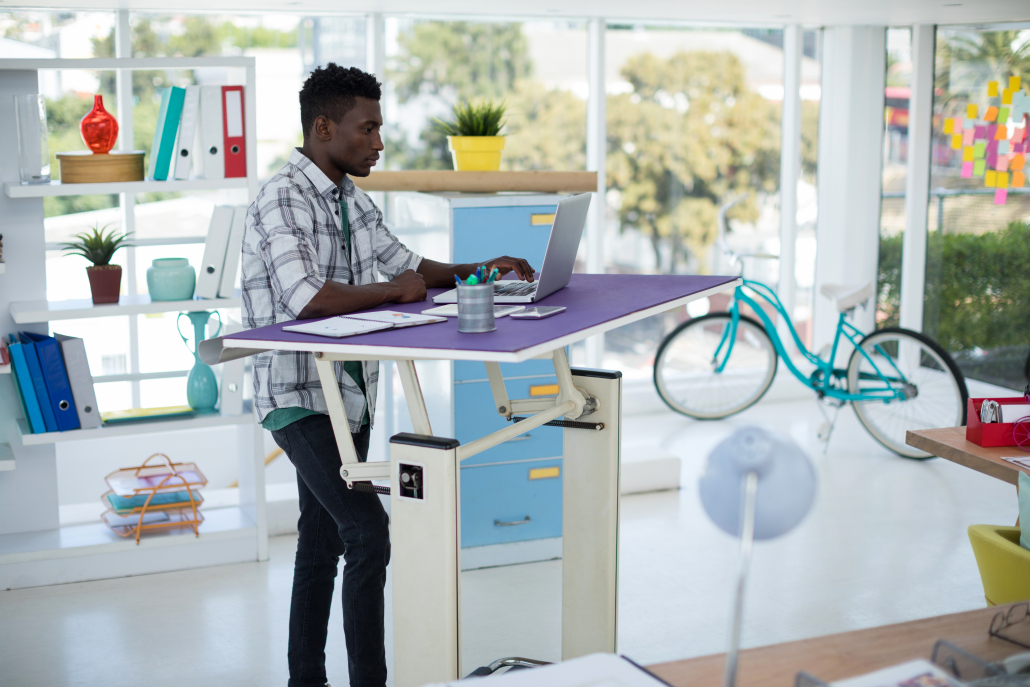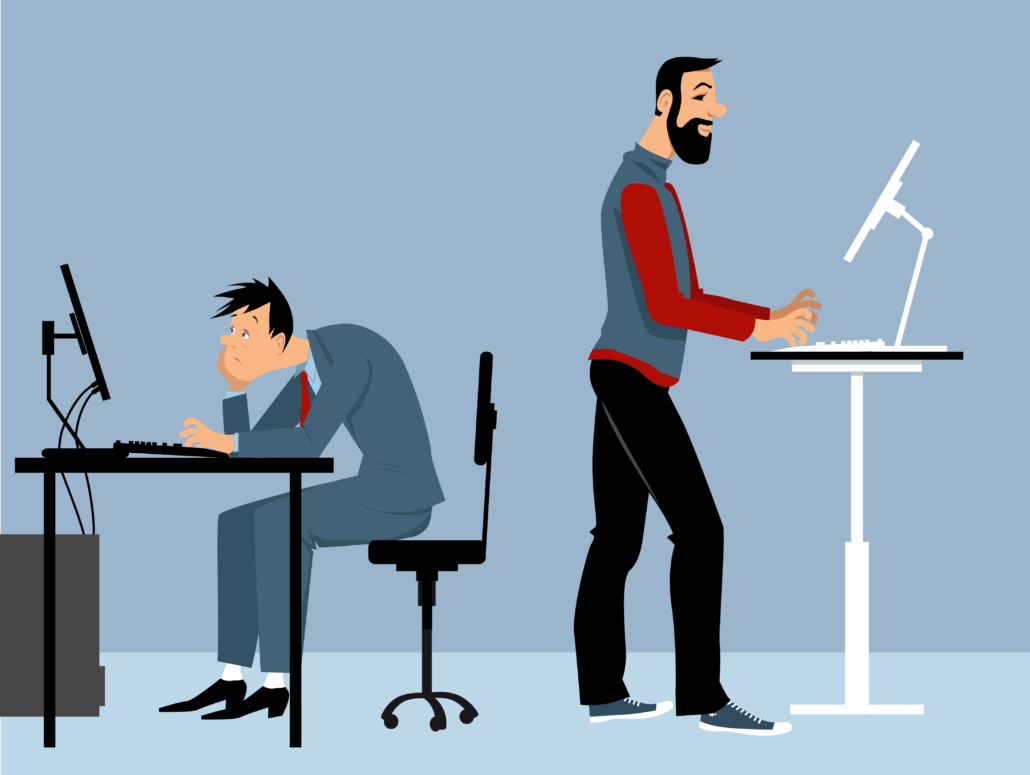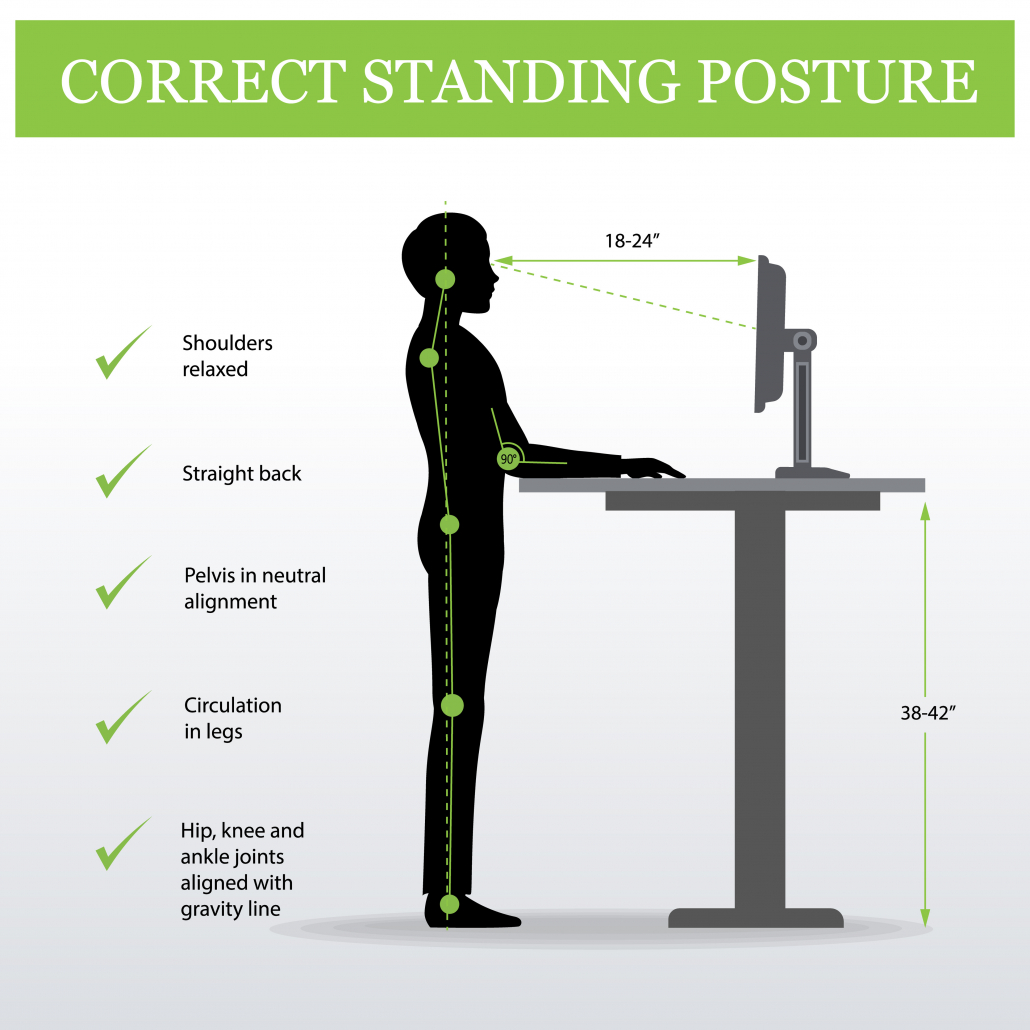We include products in articles we think are useful for our readers. If you buy products or services through links on our website, we may earn a small commission.
Top 7 Health Benefits of Standing Desks

If you’re reading this while standing at a desk, give yourself a pat on the back. You’re ahead of the curve, and part of the growing number of “desk” workers who are realizing the benefits of a standing desk.
But chances are you’re not entirely versed in why sitting is bad for you, and what exactly the health benefits of standing are? Let’s explore.
Table of Contents
Sitting is Bad for Your Health

Perhaps the biggest health benefit of a standing desk is that you’re not sitting!
Studies show that people who spend a lot of time sitting have increased risks of heart disease, diabetes, and early death [1][2].
Sitting also affects your health by contributing to weight gain because when you’re sitting, you’re not burning calories [3][4].
The difference in calories burned between a job in which you’re on your feet, and one in which you’re sitting is highlighted is dramatic. Studies show that agricultural workers can burn 1,000 more calories per day than desk workers [5].
Studies looking at data taken from over 1 million people revealed that the more sedentary your lifestyle, the more likely it is that you will die early.
In these 18 studies, the most sedentary people had a 22-49% higher risk of early death [6][7].
Unfortunately, the average worker in America spends 62% of their workday sitting [8].
The good news is that there’s something you can do about it, and it doesn’t require signing up for cross-training.
1. Standing May Increase Your Lifespan
As we see above, sitting and overall sedentary time is deadly. One study shows that reducing sitting time to a maximum of 3 hours per day may increase the life expectancy of Americans by 2 full years [9].
2. Standing Reduces Weight Gain and Risk of Obesity
Weight gain and weight loss often follow a simple equation–when you consume more calories than you burn, you get fat.
Studies show that simply standing for an afternoon part of your workday can burn over 170 calories when compared to working while sitting [8]. Extended out over a workweek, that amounts to 1000 additional calories burned.
Researchers suggest that the caloric difference between sitting and standing can alone account for the link between sitting and metabolic diseases, including diabetes and obesity [9][10].
3. Standing Desks May Lower Blood Sugar
Eating a Standard American Diet results in chronically high blood sugar levels that can contribute to chronic inflammation, hormone imbalances, and metabolic disorders like type-2 diabetes, among many other health issues [11][12].
Research has found that spending significant time sitting is linked to a 112% greater risk of type 2 diabetes [13].
One study had 10 office workers stand for 180 minutes after lunch, resulting in a reduction of post-lunch blood sugar spikes by 43% compared with a group sitting for the same length of time [14].
Significantly, both groups took the same number of steps each day, confirming that the reduction was in fact due to standing, and not to extra movement around the workspace.
Another study looked at the effect of alternating between sitting and standing every 30 minutes. Following 23 office workers, researchers discovered that blood sugar spikes were reduced by an average of 11.1% compared with a sitting group [15].
4. Standing May Reduce Risk of Heart Disease
Science has been aware of the connection between standing and reduced risk of heart disease for decades.
In 1953, a study discovered that bus conductors who stood during their day-long shifts had a 50% lower risk of heart disease compared with drivers who sat during their shifts [16].
Since then, researchers have conducted numerous studies looking at the link between sedentary time and heart health. Recent studies have shown that the effect is even more dramatic, with prolonged sedentary time increasing heart disease risk by up to 147% [17][18].
In our fast-paced modern society, people often attempt to negate the effects of sedentary hours spent sitting before a screen with short-term intensive exercise.
However, studies show that an entire hour of intensive exercise will not cancel the negative health effects of sitting for a day [19].
When looking at the research it is clear that standing is an overlooked and strikingly effective technique for boosting your heart health.
5. Standing Desks Appear to Reduce Back Pain
Sitting at a desk is a recipe for back pain. In fact, back pain is so common among Americans that it could be considered an epidemic.
Researchers estimate that $90 billion is spent on the diagnosis and management of low back pain each year, with an additional $10 to $20 billion in economic losses due to reductions in productivity [20].
Studies seeking to determine the effectiveness of standing desks for reducing back pain have been encouraging.
A 2012 study by the CDC found that using sit-stand desks for just 4 weeks reduced upper back and neck pain by 54% [21].
Strikingly, when the desks were removed, many of the improvements were reversed within two weeks.
Studies in 2014 and 26 found that after several weeks of using a standing desk, participants reported a 32% improvement in pain [22][23].
6. Standing Desks Boost Mood and Energy
Standing desks have been shown to improve mood and energy, making them an effective tool to combine with power naps and daily meditation to boost overall well-being.
A 7-week trial found that people who used standing desks had less fatigue and stress than seated co-workers, with 87% of the standing desk participants reporting more vigor through the workday [24].
As with similar tests cited above, the gains–in this case, elevated mood–returned to pre-standing desk levels when workers returned to their old desks.
These studies are in line with wider research showing that sitting and sedentary behavior is linked with increases in depression and anxiety [25][26].
7. Increased Productivity
Most of us are used to admonishing ourselves to sit down at our desks to get work done. But when considering the boosts in vigor and energy you get from standing desks, you might want to retrain that inner voice to encourage you to stand.
One of the biggest concerns about standing desks and productivity has to do with typing speed. However, a study of 60 young employees found that 4 hours each day at a standing desk had zero impact on typing speed or typing errors [27].
Another study looking specifically for possible negative effects of standing desks found that standing desks do not impact perceptual ability or working memory [28].
A 2017 study found that participants who used a standing desk exhibited greater task engagement, signified by interest, enthusiasm, and alertness, and less comfort while standing rather than sitting [29].
Studies also show that moving–and at a standing desk you are constantly, subtly moving– enhances the creation of new brain cells, improving creativity, critical thinking, and focus, all of which can contribute to productivity [30].
How to Properly Stand at a Standing Desk

Health Benefits of Standing Desks: The Bottom Line
Using a standing desk reduces sedentary time which in turn reduces risk of heart disease and metabolic risk, while improving energy, focus, mood, and overall well-being.
Pro tip: Sitting is part of using a standing desk. Most experts recommend splitting the time between sitting and standing to get the greatest benefits with the least downside. Rotating between standing and sitting is especially important when just starting out–it lets your body adjust without producing soreness.




















